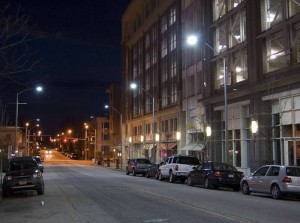Washington, DC is following in the footsteps
of a bunch of cities that have – or are in the process of – switching their
lighting to LEDs. But unlike the other cities, Washington isn’t paying the high costs
of making the switch – it is taking
advantage of Philips Lighting’s (which manufactures the LEDs) first foray into
offering a “lighting as a service” model.
While the model is commonly used to finance building retrofits, it hasn’t been
used for lighting. Philips will pay the upfront costs of installation and be compensated through a performance contract – the energy savings the retrofit produces.
In Washington, DC, Philips will upgrade over 13,000 lighting fixtures in all
its parking garages at no upfront cost to the city and provide a 10-year
maintenance contract. Philips will get paid from the $2 million in savings the
LEDs are expected to provide each year. The project starts this spring and will
take about a year.
The bulbs will automatically adjust based on the amount of natural light that’s available and software will alert Philips when repairs are needed.
“With digital lighting systems, we really need to break with conventional
thinking and look to the services and delivery models of the software industry
to understand the future of lighting and how we can remove one of the greatest
barriers to adoption: the upfront costs,” says Bruno Biasiotta, CEO of Philips
Lighting Americas.
A survey of 300 mayors released this week shows that switching to LEDs is a high
priority (82%), second only to public building retrofits (86%). LEDs and other
energy-efficient lighting are the "most promising technologies" for
reducing energy use and carbon emissions, they say. The most significant
barriers are budget constraints (84%) and upfront costs (71%).
Even with these barriers, 23% of mayors say they will continue on their
course of increasing efficiency, and 67% plan to invest more.
LED streetlights:

And while
only 36% of cities currently have a comprehensive energy plan, a third more say they will
have one within two years. 90% of mayors surveyed say they will have a plan
to keep vital services operating during sustained power outages within three
years, and 75% have already developed such plans.
At the June meeting of the US Conference of Mayors, they adopted a policy that affirms
the importance and benefits of advanced lighting systems in cities. At this
month’s meeting, they formed a partnership with Philips Lighting to help mayors with this
effort. Through the Mayors’ Lighting Partnership, Philips will provide free
energy audits, technical assistance and its new financing option.
NYC is converting all 250,000
streetlights to LEDs, and Boston and Los Angeles both recently
finished their own city-wide lighting retrofits. It’s estimated that
the 35 million streetlights in the US consume about 1% of all
electricity – and they are often the single biggest energy cost for
cities.
The market for LEDs is expected to grow 12-fold over the next decade – from $2 billion today to $25 billion in 2023, according to the lastest research from Lux.
Read our article, LED Lights: Another Challenge for Utilities.
Here’s the survey, Energy Efficiency and Technologies in America’s Cities:

 Loading...
Loading...
It would be good if Philips can do this around the globe especially in developing countries. Bravo.
While I commend Phillips for figuring out this would work to get the lights installed where they need to be, it is a shame that cities choose to resort to making deals like this rather than paying the up-front costs and letting their citizens (and future city administrators) pocket the full savings.